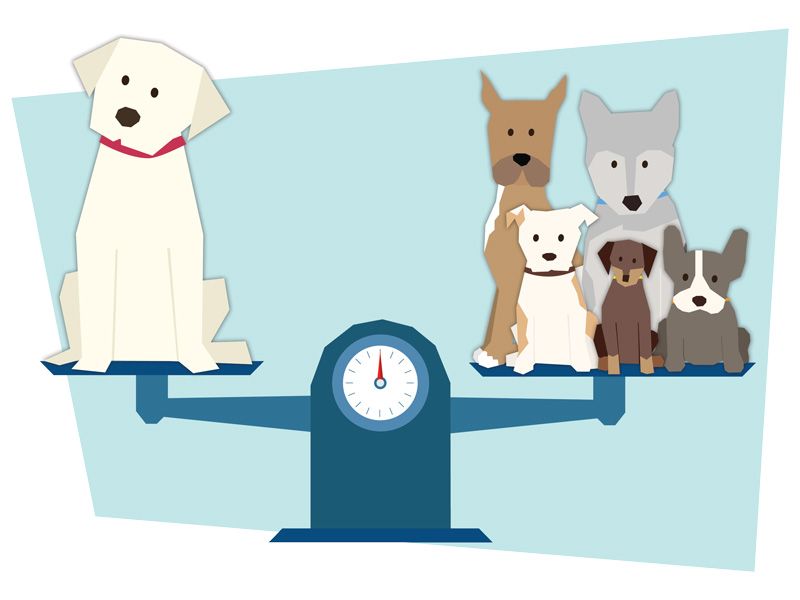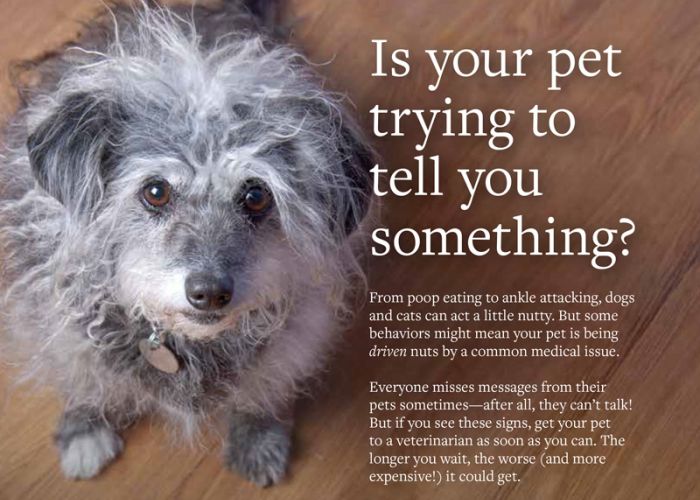When love isn’t enough
Rescue isn’t all heartwarming success stories, and sometimes hard cases call for tough decisions

With his wagging tail and happy demeanor, the golden retriever-spaniel mix looks like a friendly, approachable dog. And for a brief moment, he is.
“You can pet him for about two seconds, and then he’ll nail you,” says Karen Deeds, a trainer and certified dog behavior consultant in Fort Worth, Texas.
The young adult dog, whom Deeds refers to by the pseudonym Rigby to protect her clients’ privacy, seemed like a highly adoptable dog when a rescue group pulled him from a shelter. But in his foster home, Rigby revealed a different side. After he delivered a third bite to his foster mom, the rescue group turned to Deeds for an objective assessment: Can this dog’s behavior be modified to the point where he can safely be put up for adoption?
It’s not a simple answer. He’s barely a level 3 biter, Deeds says, referring to a severity scale where a level 3 bite is one that punctures the skin but isn’t super deep. “But he’s also not giving a lot of warning.”
The fact that Rigby is a foster dog adds another layer of challenge. Any future adopters will need to accept the liability risk of a dog with a bite record. They will need to continue his training and practice what Deeds calls “management strategies,” such as ensuring that strangers don’t pet him. That means Deeds must consider another question: How likely is Rigby to attract an adopter who meets these criteria?
“He’s snarly-snarly with other dogs and not very interested in engaging with people,” she says. Neither of these are deal breakers, but they further narrow the pool of people who might be able and willing to take on a dog like him.
At the end of his two-week stay with her, Deeds will draft an assessment and recommendations. Rigby is a borderline case, she says, so it won’t be easy.
“Recommending euthanasia is hard for me,” she says. “If you do everything right, he’s not that bad.”
“It's not a secret that euthanasia is on the table in a serious case. We're in a part of the country where shelters are full of dogs that won't bite us. It's not worth 10 of those dogs losing their lives just because we're fooling around with one.”
—Stacy Smith
Letting go of the happy ending
Ultimately, Rigby’s fate will depend on the rescuers who brought him into their foster program with the expectation of placing him in a loving home. In the coming weeks, they’ll have to decide if they can deliver that happy ending.
It’s not the kind of decision that most people expect to face when they enter this field. Judging from the internet, rescue is all about heartwarming transformations, from former fighting dogs who become therapy animals to seemingly uncontrollable collie mixes who find their calling in agility competitions.
These are the outcomes that keep rescuers going. But they’re not the entire picture, says Britney Wallesch, executive director of Black Dog Animal Rescue in Cheyenne, Wyoming. Because sometimes rescue groups take in dogs who can’t be transformed, despite their best efforts, leaving euthanasia as the only viable option.
If rescuers aren’t emotionally prepared for that possibility, they can be overwhelmed by stress, guilt and grief. Wallesch discovered that several years ago when she made the decision to euthanize her foster dog, Jessi, after she’d spent 18 months trying to solve her aggression issues and searching fruitlessly for a reputable sanctuary or nonprofit training center that could take her.
Before Jessi came into her life, Wallesch believed any dog could be rehabilitated with enough time and effort. “I had kind of a starry-eyed vision of fixing all of the problems,” she says. “I don’t think I realized how utterly complicated [dogs] could be.”
Jessi’s death left her “personally wrecked,” sometimes paralyzed by grief and other times overcome by panic. On the cusp of quitting rescue altogether, she turned to the online rescue community for moral support. She learned that many people had similar experiences—they just weren’t talking about it openly. Some felt ashamed of their perceived failure; others feared being verbally attacked for their decision. In the rescue world, Wallesch discovered, euthanasia was “a dark dirty word.”
The experience marked a turning point in her rescue philosophy. While she’d once believed that it was her “moral responsibility” to find a home for any dog in her care, no matter what, she came to realize that she also had a responsibility to her volunteers, her community and the reputation of rescue dogs everywhere.
She now accepts that of the 500 or so dogs Black Dog pulls from shelters each year, a few will turn out to have serious behavior issues that will lead to euthanasia. And she continues to encourage open conversation about euthanasia in the rescue community.
“People need to be able to talk about it,” she says, “and forgive themselves for making that decision.”

Limits of hope
Dogs, like people, are complex emotional beings. Genetics, development issues, life experiences and training all have a role in shaping an individual’s temperament and emotional resilience, says Deeds. Some can bounce back from horrific pasts, while others with no history of trauma or mistreatment develop serious aggression issues or crippling mental illnesses.
In any given week, Deeds witnesses the varied ways that dogs can frustrate people’s sincere efforts to love them and provide them with a good life. Many of her rescue clients are experienced dog handlers who enjoy the challenge of teaching a dominant dog some impulse control or instilling confidence in a timid pup. But when a dog’s actions fall outside the range of normal canine behavior—or present a serious safety threat—what the typical rescuer can offer is often not enough.
So how do rescuers determine when a dog’s behavior goes beyond what can be solved or managed? There are no set formulas and a lot of gray areas. But the first step is to make sure the behavior isn’t the result of a medical problem, such as undiagnosed pain, she says. Barring that, your next step should be to consult trainers or other experienced animal professionals and think through what your organization can realistically achieve.
When a decision is unclear, Deeds will guide her rescue clients through a series of questions like, “Does the group have a foster caregiver with the time and expertise to work with the dog for several months or more? Can the foster safely manage the dog until the behavior can be minimized through training and perhaps medication? Does the foster have the right environment and household dynamics to ensure the dog isn’t a risk to others? In the case of severe separation anxiety, can the foster ensure the dog isn’t left alone until he’s made enough progress? What is the dog’s quality of life now, and if poor, can it be improved?”
“A lot of it boils down to resources,” says Sarah Barnett, a longtime volunteer for the Lost Dog and Cat Rescue Foundation (LDCRF) in Arlington, Virginia (and public affairs adviser and special assistant to the COO at The HSUS). That can entail everything from foster home capacity and volunteer expertise to bank balances and access to professional help. Many organizations, Barnett points out, aren’t in areas with access to trainers and behaviorists, or simply can’t afford dozens of one-on-one sessions with a professional.
LDCRF is fortunate: A local trainer who donates her services has turned around many difficult dogs, Barnett says. Another volunteer trainer works wonders with separation anxiety cases. And unlike many rescues, LDCRF has a kennel facility. If a foster family suddenly realizes they can’t manage a dog, there’s a safe place for the animal to stay while the group considers other options or looks for a more experienced foster home.
But even with these resources, some dogs simply don’t make the necessary progress. Over the past 16 years, LDCRF has euthanized about 50 dogs for behavior issues (compared to the nearly 30,000 pets it has placed).
One dog who couldn’t overcome her issues was a 4-year-old Staffordshire terrier mix nicknamed Bean. She had an adorable face, with black splotches framing her eyes like clown makeup, but she was randomly aggressive toward men and other dogs. The general consensus among those who knew her was that she simply wasn’t “wired right.”
For six months, Barnett and several trainers tried a variety of techniques to turn Bean around. They took her for long walks around the streets of Northern Virginia, trying to identify her exact triggers so that they could work on them. But while Bean snuggled in bed with Barnett every night, she remained unpredictable around men and other dogs.
“She was a beautiful dog, and I loved her,” Barnett says. “But I had to ask myself, who would we be OK adopting this dog out to? The issue was she didn’t have just one issue, and she wasn’t consistent. You couldn’t tell an owner what to avoid, where to be alert. You had to be alert all the time.”
Barnett considered adopting Bean herself. But she lived in a basement studio apartment. Keeping Bean would mean she could no longer foster other dogs who deserved a chance. And it would mean subjecting herself to the daily anxiety of walking an unpredictable dog in a neighborhood with a lot of children.
After much discussion, she and the group’s directors decided to have Bean euthanized. At the veterinary clinic, Barnett held Bean’s head in her lap while the drugs took effect.
“Some people say that every dog deserves to be saved,” Barnett says. “Yes, they deserve it, but it’s not always possible.”

No snap decisions
No matter how reasonable or justified, ending the life of an otherwise healthy dog is never easy. The problem behaviors almost never manifest right away, so “now you’re attached to the dog,” says Stacy Smith, executive director of Humane Tomorrow in Flower Mound, Texas. “You’re going through that phase of, ‘95 percent of the time, he’s a great dog.’”
Barnett recommends that rescue groups prepare for these situations by creating decision-making protocols and basic criteria in advance. “It helps with emotional attachment if you can tell yourself, ‘When I was thinking a bit more objectively, this is what I decided would be the point where I would start to consider euthanasia.’”
Even if you know the dog better than anyone else in your organization, it’s always a good practice to solicit trusted opinions, since people can have different viewpoints about what constitutes a “serious” behavior problem, a decent quality of life, an acceptable level of risk or even an “adoptable” dog. That’s one reason why LDCRF takes a collective approach to serious behavior cases: “It’s not just so one person doesn’t feel solely responsible or carry the emotional burden, but also to get different input,” Barnett says. “One dog who one person might think can’t be placed, another person might have a solution.”
At Humane Tomorrow, euthanasia decisions are made by a three-person committee that studies all the options, says Smith. They’ll ask questions like, “Have we had him evaluated by a behaviorist? Have we tried medication? Do we have a foster committed to work to turn the dog around?”
For a dog with a bite history, they’ll think about the severity and circumstances of past bites, the predictability of his triggers and his potential for causing serious harm to others. In other cases, the dog’s quality of life might be the deciding factor. “There are some dogs who hardly anyone can live with, like with massive separation anxiety or extreme fearfulness,” Smith says. “Some don’t come back from that. So I have to think, ‘OK, I have a dog that’s taking up foster space [and is] terrified all the time even in the safe space he’s been in for months. Are we really doing that dog a service?’” Of the 600 dogs the rescue pulls from local shelters each year, about four are eventually euthanized for behavior reasons.
When euthanasia decisions are handled in a professional way, it helps assure staff and volunteers that choices aren’t made lightly, says Barnett, adding that it’s important to have open conversations with your staff and volunteers. At LDCRF, “on the rare occasions when a dog is euthanized for behavioral reasons, the directors will talk with the volunteers, saying ‘Here’s what happened; here’s why we made the decision we did.’”
Smith believes that organizational culture and transparency, combined with awareness of local realities, help to minimize conflict over euthanasia decisions in her group. “It’s not a secret that euthanasia is on the table in a serious case,” she says. “We’re in a part of the country where shelters are full of dogs that won’t bite us. It’s not worth 10 of those dogs losing their lives just because we’re fooling around with one.”
At the same time, she and the group’s other leaders are mindful that people will experience loss and grief. “We try really hard to make [our volunteers] feel like they haven’t failed,” Smith says. “They have a job to do, which is to save as many dogs as possible by fostering.”
“I think it's almost always worthwhile to bring a dog into your rescue and give him a chance ... but you have to be willing to draw the line somewhere.”
—Sarah Barnett
New chances to take
Fortunately, most dogs need little more than proper care, a sense of security and a bit of human guidance to become reasonably well-behaved pets. And they don’t need to be paragons of good manners to be adoptable; after all, American households are full of imperfect yet beloved companion animals.
As an experienced rescue volunteer, Barnett knows that just because a dog growls over his food bowl or has a bite history doesn’t mean he’s a lost cause. She’s fostered and helped train many dogs in that category who went on to be wonderful pets.
However, rescuers must be completely transparent with adopters about a dog’s history and challenges. It can be tempting to gloss over behavior problems or to hide incidents that weren’t the dog’s fault, Barnett admits. (Perhaps he was startled while sleeping and nipped a toddler who tripped over him.) Rescuers can certainly explain the context of any incidents, but “you still need to disclose,” she says.
Of the nearly 100 dogs Barnett has fostered to date, three were eventually determined to be inappropriate for adoption and euthanized. It’s always sad, sometimes heartbreaking, but in the end, she believes that accepting euthanasia as an outcome in these rare cases empowers the organization to give more dogs a chance.
Without euthanasia as a last-resort option, LDCRF might not be able to take chances on dogs like Dimitri, a shar-pei with a bad skin condition who came from a puppy mill. At the shelter, Dimitri spent his days spinning nonstop inside his kennel. Shelter staff sensed that the compulsive behavior was a reaction to stress and asked LDCRF to take him into foster care. The rescue group took the gamble, and Dimitri blossomed into a charming, happy dog. By then, Barnett was living in a larger apartment, and she eventually adopted him.
“I think it’s almost always worthwhile to bring a dog into your rescue and give him a chance, depending on what resources you have available,” she says, “but you have to be willing to draw the line somewhere.”
With this in mind, several times each year, LDCRF staff and volunteers visit shelters and meet dogs who aren’t behaving in a way that’s likely to attract adopters. While the team focuses their efforts on dogs who appear friendly to people and other canines, they also know that many dogs simply can’t handle the stress of being in a shelter. So they’ll often decide to give some questionable pups an opportunity to go into a foster home and show a better side of their personalities.
In nearly all cases, their gut instincts are right, and the dogs are fine. It’s a testament to canine resiliency that the vast majority are.






